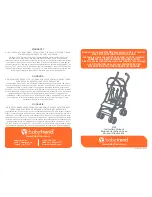AND8344/D
6
The SMPS is turned from standby mode to full power by
a signal on the EN pin. This signal can be either negative or
positive (the PCB is designed for this). In this configuration,
SMPS is turned on by enabling the EN pin and turned off by
grounding the pin. Transistor Q21 is turned on through
resistor R123. Optocoupler OK2 is activated from +5 V
STBY and through R96. Once the optocoupler is activated,
a positive voltage from C56 is brought to diode D31 and to
the base of Q13. This positive voltage turns on Q13 and
provides bias to the main LLC and PFC circuit. Transistor
Q14 and diode D32 provide voltage for the rest of the SMPS.
In case the standby operates with no load, the rectified
voltage on C55 is very small. An additional drop on the R104
diminishes the voltage even more and the voltage on the
emitter of Q13 may be too low to reach the level of
13.1 V
max
at which the PFC stage starts. Thus, the PFC stage
never starts operating. Because of negative current sense of
the NCP1351B, it is not possible to connect voltage from
C55 directly to capacitor C56 because the current charging
this capacitor flows through R129 and R130 and is
registered by NCP1351. Due to this fact, voltage regulation
by Q14 and D32 is beneficial only when the SMPS starts
with a no load condition on the secondary side. Another
regulator is created by Q13 and D31 is necessary for
regulating the voltage from the auxiliary winding of TR1.
Figure 7 shows the power consumption when only the
standby stage is operating (LLC and PFC are disabled), with
loads of 0.5 W, 0.1 W and no load. Consumption is below
1 W for a 0.5 W load and below 0.4 W for a 0.1 W load.
The standby efficiency meets the requirements of today’s
energy efficiency regulation.
STBY Consumption
0
100
200
300
400
500
600
700
800
900
1000
85
105
125
145
165
185
205
225
245 265
Input voltage [V]
Input power [mW]
Figure 7. Standby Consumption vs. Line Voltage
500mW load
100mW load
No load
Main LLC Power Supply
Figure 8. The LLC Primary Side Schematic
Summary of Contents for NCP1351B
Page 19: ...AND8344 D www onsemi com 19 Figure 47 Schematic of the SMPS...
Page 20: ...AND8344 D www onsemi com 20 Figure 48 Bottom Side of the PCB...
Page 21: ...AND8344 D www onsemi com 21 Figure 49 Bottom Labels...
Page 22: ...AND8344 D www onsemi com 22 Figure 50 Top Labels...
Page 24: ...AND8344 D www onsemi com 24 Figure 52 Photo of the Demoboard with Heatsinks Removed...
Page 25: ...AND8344 D www onsemi com 25 Figure 53 Photo of the Demoboard Bottom Side...
Page 26: ...AND8344 D www onsemi com 26...
Page 27: ...AND8344 D www onsemi com 27...


















